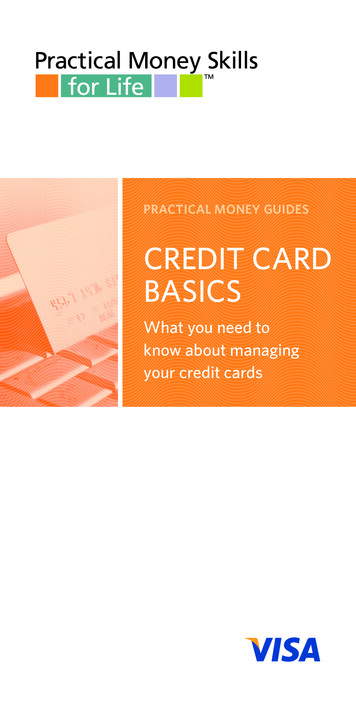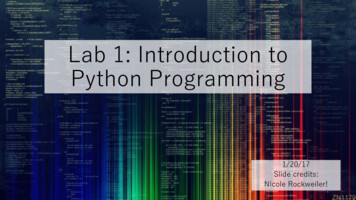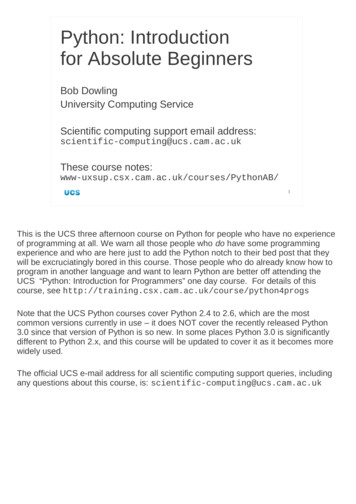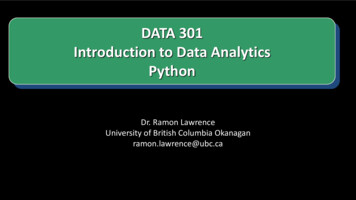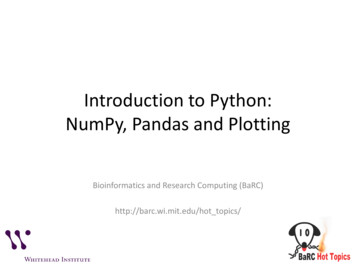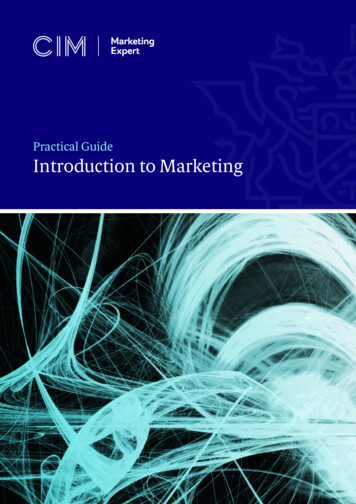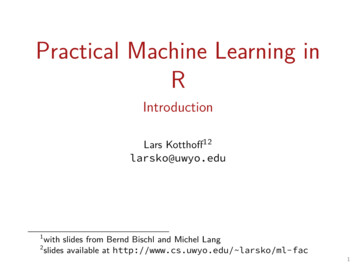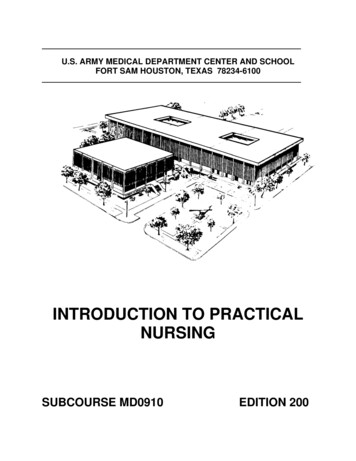
Transcription
Python Basics: A Practical Introductionto Python 3Real Python
Python Basics: A Practical Introduction to Python 3Revised and Updated 4th EditionDavid Amos, Dan Bader, Joanna Jablonski, Fletcher HeislerCopyright Real Python (realpython.com), 2012–2020For online information and ordering of this and other books by RealPython, please visit realpython.com. For more information, pleasecontact us at info@realpython.com.ISBN: 9781775093329 (paperback)ISBN: 9781775093336 (electronic)Cover design by Aldren SantosAdditional editing and proofreading by Jacob Schmitt“Python” and the Python logos are trademarks or registered trademarks of the Python Software Foundation, used by Real Python withpermission from the Foundation.Thank you for downloading this ebook. This ebook is licensed for yourpersonal enjoyment only. This ebook may not be resold or given awayto other people. If you would like to share this book with another person, please purchase an additional copy for each recipient. If you’rereading this book and did not purchase it, or if it was not purchased foryour use only, then please return to realpython.com/pybasics-bookand purchase your own copy. Thank you for respecting the hard workbehind this book.
This is a sample from “Python Basics: A PracticalIntroduction to Python 3”With the full version of the book you get a complete Python curriculumto go all the way from beginner to intermediate-level. Every step alongthe way is explained and illustrated with short & clear code samples.Coding exercises within each chapter and our interactive quizzes helpfast-track your progress and ensure you always know what to focus onnext.Become a fluent Pythonista and gain programming knowledge youcan apply in the real-world, today:If you enjoyed the sample chapters you can purchase a fullversion of the book at realpython.com/pybasics-book
What Pythonistas Say About Python Basics: A Practical Introduction to Python 3“I love [the book]! The wording is casual, easy to understand, andmakes the information ow well. I never feel lost in the material, andit’s not too dense so it’s easy for me to review older chapters over andover.I’ve looked at over 10 di erent Python tutorials/books/online courses,and I’ve probably learned the most from Real Python!”— Thomas Wong“Three years later and I still return to my Real Python books when Ineed a quick refresher on usage of vital Python commands.”— Rob Fowler“I oundered for a long time trying to teach myself. I slogged throughdozens of incomplete online tutorials. I snoozed through hours of boring screencasts. I gave up on countless crufty books from big-timepublishers. And then I found Real Python.The easy-to-follow, step-by-step instructions break the big conceptsdown into bite-sized chunks written in plain English. The authorsnever forget their audience and are consistently thorough and detailedin their explanations. I’m up and running now, but I constantly referto the material for guidance.”— Jared Nielsen
“I love the book because at the end of each particular lesson there arereal world and interesting challenges. I just built a savings estimatorthat actually re ects my savings account – neat!”— Drew Prescott“As a practice of what you taught I started building simple scripts forpeople on my team to help them in their everyday duties. When mymanagers noticed that, I was o ered a new position as a developer.I know there is heaps of things to learn and there will be huge challenges, but I nally started doing what I really came to like.Once again: MANY THANKS!”— Kamil“What I found great about the Real Python courses compared to othersis how they explain things in the simplest way possible.A lot of courses, in any discipline really, require the learning of a lot ofjargon when in fact what is being taught could be taught quickly andsuccinctly without too much of it. The courses do a very good job ofkeeping the examples interesting.”— Stephen Grady“After reading the rst Real Python course I wrote a script to automatea mundane task at work. What used to take me three to ve hours nowtakes less than ten minutes!”— Brandon Youngdale
“Honestly, throughout this whole process what I found was just melooking really hard for things that could maybe be added or improved,but this tutorial is amazing! You do a wonderful job of explaining andteaching Python in a way that people like me, a complete novice, couldreally grasp.The ow of the lessons works perfectly throughout. The exercises trulyhelped along the way and you feel very accomplished when you nishup the book. I think you have a gift for making Python seem moreattainable to people outside the programming world.This is something I never thought I would be doing or learning andwith a little push from you I am learning it and I can see that it will benothing but bene cial to me in the future!”— Shea Klusewicz“The authors of the courses have NOT forgotten what it is like to bea beginner – something that many authors do – and assume nothing about their readers, which makes the courses fantastic reads. Thecourses are also accompanied by some great videos as well as plentyof references for extra learning, homework assignments and examplecode that you can experiment with and extend.I really liked that there was always full code examples and each lineof code had good comments so you can see what is doing what.I now have a number of books on Python and the Real Python onesare the only ones I have actually nished cover to cover, and theyare hands down the best on the market. If like me, you’re not a programmer (I work in online marketing) you’ll nd these courses to belike a mentor due to the clear, u -free explanations! Highly recommended!”— Craig Addyman
About the AuthorsAt Real Python you’ll learn real-world programming skills from a community of professional Pythonistas from all around the world.The realpython.com website launched in 2012 and currently helpsmore than three million Python developers each month with freeprogramming tutorials and in-depth learning resources.Everyone who worked on this book is a practitioner with several yearsof professional experience in the software industry. Here are the members of the Real Python tutorial team who worked on Python Basics:David Amos is the content technical lead for Real Python. After leaving academia in 2015, David worked in various technical positions asa programmer and data scientist. In 2019, David joined Real Pythonfull time to pursue his passion for education. He lead the charge onrewriting and updating the Python Basics curriculum to Python 3.Dan Bader is the owner and editor in chief of Real Python and themain developer of the realpython.com learning platform. Dan hasbeen writing code for more than twenty years and holds a master’sdegree in computer science. He’s the author of Python Tricks, a bestselling programming book for intermediate Python developers.Joanna Jablonski is the executive editor of Real Python. She likesnatural languages just as much as she likes programming languages.Her love for puzzles, patterns, and pesky little details led her to followa career in translation. It was only a matter of time before she wouldfall in love with a new language: Python! She joined Real Python in2018 and has been helping Pythonistas level up ever since.Fletcher Heisler is the founder of Hunter2, where he teaches developers how to hack and secure modern web apps. As one of thefounding members of Real Python, Fletcher wrote the first version ofthe Python curriculum this book is based on in 2012.
ContentsContents8Foreword1234Introduction1.1 Why This Book? . . . . . . . . . . . . .1.2 About Real Python . . . . . . . . . . .1.3 How to Use This Book . . . . . . . . . .1.4 Bonus Material and Learning ResourcesSetting Up Python2.1 A Note on Python Versions2.2 Windows . . . . . . . . .2.3 macOS . . . . . . . . . . .2.4 Ubuntu Linux . . . . . . .13.Your First Python Program3.1 Write a Python Program . . . . . . . . .3.2 Mess Things Up . . . . . . . . . . . . . .3.3 Create a Variable . . . . . . . . . . . . .3.4 Inspect Values in the Interactive Window3.5 Leave Yourself Helpful Notes . . . . . . .3.6 Summary and Additional Resources . . .Strings and String Methods4.1 What Is a String? . . . . . . . . . . . . . . . . . . .4.2 Concatenation, Indexing, and Slicing . . . . . . . . .82021232425293031343742434750555860626369
Contents56784.34.44.54.64.74.84.94.10Manipulate Strings With Methods . . . . . .Interact With User Input . . . . . . . . . . .Challenge: Pick Apart Your User’s Input . . .Working With Strings and Numbers . . . . .Streamline Your Print Statements . . . . . .Find a String in a String . . . . . . . . . . . .Challenge: Turn Your User Into a L33t H4x0rSummary and Additional Resources . . . . .Numbers and Math5.1 Integers and Floating-Point Numbers . . . . .5.2 Arithmetic Operators and Expressions . . . . .5.3 Challenge: Perform Calculations on User Input5.4 Make Python Lie to You . . . . . . . . . . . . .5.5 Math Functions and Number Methods . . . . .5.6 Print Numbers in Style . . . . . . . . . . . . .5.7 Complex Numbers . . . . . . . . . . . . . . .5.8 Summary and Additional Resources . . . . . .Functions and Loops6.1 What Is a Function, Really? . . . . .6.2 Write Your Own Functions . . . . .6.3 Challenge: Convert Temperatures .6.4 Run in Circles . . . . . . . . . . . .6.5 Challenge: Track Your Investments .6.6 Understand Scope in Python . . . .6.7 Summary and Additional Resources. 79. 85. 88. 88. 94. 96. 99. 57162Finding and Fixing Code Bugs1647.1 Use the Debug Control Window . . . . . . . . . . . 1657.2 Squash Some Bugs . . . . . . . . . . . . . . . . . . 1717.3 Summary and Additional Resources . . . . . . . . . 179Conditional Logic and Control Flow1818.1 Compare Values . . . . . . . . . . . . . . . . . . . . 1828.2 Add Some Logic . . . . . . . . . . . . . . . . . . . . 1868.3 Control the Flow of Your Program . . . . . . . . . . 1949
Contents98.48.58.68.78.88.98.10Challenge: Find the Factors of a Number . .Break Out of the Pattern . . . . . . . . . .Recover From Errors . . . . . . . . . . . .Simulate Events and Calculate ProbabilitiesChallenge: Simulate a Coin Toss ExperimentChallenge: Simulate an Election . . . . . .Summary and Additional Resources . . . .Tuples, Lists, and Dictionaries9.1 Tuples Are Immutable Sequences . . . . . . . .9.2 Lists Are Mutable Sequences . . . . . . . . . .9.3 Nesting, Copying, and Sorting Tuples and Lists9.4 Challenge: List of lists . . . . . . . . . . . . . .9.5 Challenge: Wax Poetic . . . . . . . . . . . . .9.6 Store Relationships in Dictionaries . . . . . . .9.7 Challenge: Capital City Loop . . . . . . . . . .9.8 How to Pick a Data Structure . . . . . . . . . .9.9 Challenge: Cats With Hats . . . . . . . . . . .9.10 Summary and Additional Resources . . . . . .10 Object-Oriented Programming (OOP)10.1 Define a Class . . . . . . . . . . . . .10.2 Instantiate an Object . . . . . . . . .10.3 Inherit From Other Classes . . . . . .10.4 Challenge: Model a Farm . . . . . . .10.5 Summary and Additional Resources .11 Modules and Packages11.1 Working With Modules . . . . . . . . . . . . . . . .11.2 Working With Packages . . . . . . . . . . . . . . . .11.3 Summary and Additional Resources . . . . . . . . .12 File Input and Output12.1 Files and the File System . . . . . . . . . . . . . .12.2 Working With File Paths in Python . . . . . . . . .12.3 Common File System Operations . . . . . . . . . .12.4 Challenge: Move All Image Files to a New 32433335010
Contents12.512.612.712.8Reading and Writing Files . . . . .Read and Write CSV Data . . . . . .Challenge: Create a High Scores ListSummary and Additional Resources.35136637737813 Installing Packages With pip37913.1 Installing Third-Party Packages With pip . . . . . . . 38013.2 The Pitfalls of Third-Party Packages . . . . . . . . . 39013.3 Summary and Additional Resources . . . . . . . . . 39214 Creating and Modifying PDF Files14.1 Extracting Text From a PDF . . . .14.2 Extracting Pages From a PDF . . . .14.3 Challenge: PdfFileSplitter Class . .14.4 Concatenating and Merging PDFs .14.5 Rotating and Cropping PDF Pages .14.6 Encrypting and Decrypting PDFs . .14.7 Challenge: Unscramble a PDF . . .14.8 Creating a PDF File From Scratch .14.9 Summary and Additional Resources.39439540240941041742843343344016 Interacting With the Web16.1 Scrape and Parse Text From Websites .16.2 Use an HTML Parser to Scrape Websites16.3 Interact With HTML Forms . . . . . . .16.4 Interact With Websites in Real Time . .16.5 Summary and Additional Resources . .458459469475481485.15 Working With Databases44215.1 An Introduction to SQLite . . . . . . . . . . . . . . 44315.2 Libraries for Working With Other SQL Databases . . 45515.3 Summary and Additional Resources . . . . . . . . . 45617 Scienti c Computing and Graphing17.1 Use NumPy for Matrix Manipulation . . . . . . . . .17.2 Use Matplotlib for Plotting Graphs . . . . . . . . . .17.3 Summary and Additional Resources . . . . . . . . .48748849952211
Contents18 Graphical User Interfaces18.1 Add GUI Elements With EasyGUI . . . . . .18.2 Example App: PDF Page Rotator . . . . . . .18.3 Challenge: PDF Page Extraction Application .18.4 Introduction to Tkinter . . . . . . . . . . . .18.5 Working With Widgets . . . . . . . . . . . .18.6 Controlling Layout With Geometry Managers18.7 Making Your Applications Interactive . . . .18.8 Example App: Temperature Converter . . . .18.9 Example App: Text Editor . . . . . . . . . .18.10 Challenge: Return of the Poet . . . . . . . . .18.11 Summary and Additional Resources . . . . .19 Final Thoughts and Next Steps19.1 Free Weekly Tips for Python Developers19.2 Python Tricks: The Book . . . . . . . .19.3 Real Python Video Course Library . . .19.4 Acknowledgements . . . . . . . . . . 2412
ForewordHello, and welcome to Python Basics: A Practical Introduction toPython 3. I hope you’re ready to learn why so many professional andhobbyist developers are drawn to Python and how you can beginusing it on your own projects, small and large, right away.This book is targeted at beginners who either know a little programming but not the Python language and ecosystem or are starting freshwith no programming experience whatsoever.If you don’t have a computer science degree, don’t worry. David, Dan,Joanna, and Fletcher will guide you through the important computing concepts while teaching you the Python basics and, just as importantly, skipping the unnecessary details at first.Python Is a Full-Spectrum LanguageWhen learning a new programming language, you don’t yet have theexperience to judge how well it will serve you in the long run. If you’reconsidering learning Python, let me assure you that this is a goodchoice. One key reason is that Python is a full-spectrum language.What do I mean by this? Some languages are very good for beginners.They hold your hand and make programming super easy. We can goto the extreme and look at visual languages such as Scratch.In Scratch, you get blocks that represent programming concepts likevariables, loops, method calls, and so on, and you drag and drop themon a visual surface. Scratch may be easy to get started with for sim13
Contentsple programs, but you cannot build professional applications with it.Name one Fortune 500 company that powers its core business logicwith Scratch.Come up empty? Me too, because that would be insanity.Other languages are incredibly powerful for expert developers. Themost popular one in this category is likely C and its close relative,C. Whichever web browser you used today was likely written in C orC . Your operating system running that browser was very likely alsobuilt with C/C . Your favorite first-person shooter or strategy videogame? You nailed it: C/C .You can do amazing things with these languages, but they are whollyunwelcoming to newcomers looking for a gentle introduction.You might not have read a lot of C code. It can almost make youreyes burn. Here’s an example, a real albeit complex one:template typename T Defer void(*(PID T , void (T::*)(void)))(const PID T &, void (T::*)(void)) defer(const PID T & pid, void (T::*method)(void)){void (*dispatch)(const PID T &, void (T::*)(void)) &process::template dispatch T ;return std::tr1::bind(dispatch, pid, method);}Please, just no.Both Scratch and C are decidedly not what I would call fullspectrum languages. With Scratch, it’s easy to start, but you have toswitch to a “real” language to build real applications. Conversely, youcan build real apps with C , but there’s no gentle on-ramp. Youdive headfirst into all the complexity of the language, which exists tosupport these rich applications.14
ContentsPython, on the other hand, is special. It is a full-spectrum language.We often judge the simplicity of a language based on the Hello, Worldtest. That is, what syntax and actions are necessary to get the languageto output Hello, World to the user? In Python, it couldn’t be simpler:print("Hello, World")That’s it! However, I find this an unsatisfying test.The Hello, World test is useful but really not enough to show the poweror complexity of a language. Let’s try another example. Not everything here needs to make total sense—just follow along to get the Zenof it. The book covers these concepts and more as you go through. Thenext example is certainly something you could write as you get nearthe end of the book.Here’s the new test: What would it take to write a program that accesses an external website, downloads the content to your app in memory, then displays a subsection of that content to the user? Let’s trythat experiment using Python 3 with the help of the requests package(which needs to be installed—more on that in chapter 12):import requestsresp requests.get("http://olympus.realpython.org")html resp.textprint(html[86:132])Incredibly, that’s it! When run, the program outputs something likethis: h2 Please log in to access Mount Olympus: /h2 This is the easy, getting-started side of the Python spectrum. A fewtrivial lines can unleash incredible power. Because Python has accessto so many powerful but well-packaged libraries, such as requests, it’soften described as having batteries included.15
ContentsSo there you have a simple yet powerful starter example. On the realworld side of things, many incredible applications have been writtenin Python as well.YouTube, the world’s most popular video streaming site, is written inPython and processes more than a million requests per second. Instagram is another example of a Python application. Closer to home, weeven have realpython.com and my sites, such as talkpython.fm.This full-spectrum aspect of Python means that you can start withthe basics and adopt more advanced features as your application demands grow.Python Is PopularYou might have heard that Python is popular. It may seem that itdoesn’t really matter how popular a language is so long as you canbuild the app you want to build with it.But, for better or worse, the popularity of a programming languageis a strong indicator of the quality of libraries you’ll have available aswell the number of job openings you’ll find. In short, you should tendto gravitate toward more popular technologies as there will be morechoices and integrations available.So, is Python actually that popular? Yes it is. You’ll find a lot ofhype and hyperbole, but there are plenty of stats backing this claim.Let’s look at some analytics presented by stackoverflow.com, a popular question-and-answer site for programmers.Stack Overflow runs a site called Stack Overflow Trends where you canlook at the trends for various technologies by tag. When you compare16
ContentsPython to the other likely candidates you could pick to learn programming, you’ll see one is unlike the others:You can explore this chart and create similar charts to this one over atinsights.stackoverflow.com/trends.Notice the incredible growth of Python compared to the flat or evendownward trend of the other usual candidates! If you’re betting yourfuture on the success of a given technology, which one would youchoose from this list?That’s just one chart—what does it really tell us? Well, let’s look atanother. Stack Overflow does a yearly survey of developers. It’s comprehensive and very well done. You can find the full 2020 results atinsights.stackoverflow.com/survey/2020.From that writeup, I’d like to call your attention to a section titled“Most Loved, Dreaded, and Wanted Languages.” In the “MostWanted” section, you’ll find data on the share of “developers who arenot developing with the language or technology but have expressedinterest in developing with it.”17
ContentsAgain, in the graph below, you’ll see that Python is topping the chartsand is well above even second place:If you agree with me that the relative popularity of a programminglanguage matters, then Python is clearly a good choice.We Don’t Need You to Be a Computer ScientistOne other point that I want to emphasize as you start your Pythonlearning journey is that we don’t need you to be a computer scientist.If that’s your goal, then great. Learning Python is a powerful stepin that direction. But the invitation to learn programming is oftenframed as “We have all these developer jobs going unfilled! We needsoftware developers!”That may or may not be true. But, more importantly, programming(even a little programming) can be a personal superpower for you.To illustrate this idea, suppose you are a biologist. Should you dropout of biology and get a job as a front-end web developer? Probablynot. But skills such as the one I opened this foreword with, using requests to get data from the Web, can be incredibly powerful for you asa biologist.Rather than manually exporting and scraping data from the Web orfrom spreadsheets, you can use Python to scrape thousands of datasources or spreadsheets in the time it takes you to do just one man18
Contentsually. Python skills can take your biology power and amplify it wellbeyond your colleagues’ to make it your superpower.Dan and Real PythonFinally, let me leave you with a comment on your authors. Dan Baderand the other Real Python authors work day in and day out to bringclear and powerful explanations of Python concepts to all of us viarealpython.com.They have a unique view into the Python ecosystem and are keyed intowhat beginners need to know.I’m confident leaving you in their hands on this Python journey. Goforth and learn this amazing language using this great book. Mostimportantly, remember to have fun!— Michael Kennedy, Founder of Talk Python (@mkennedy)19
Chapter 1IntroductionWelcome to Real Python’s Python Basics book, fully updated forPython 3.9! In this book, you’ll learn real-world Python programming techniques, illustrated with useful and interesting examples.Whether you’re a new programmer or a professional software developer looking to dive into a new language, this book will teach you allthe practical Python that you need to get started on projects of yourown.No matter what your ultimate goals may be, if you work with a computer at all, then you’ll soon be finding endless ways to improve yourlife by automating tasks and solving problems through Python programs that you create.But what’s so great about Python as a programming language? Forone, Python is open source freeware, meaning you can download itfor free and use it for any purpose, commercial or not.Python also has an amazing community that has built a number ofuseful tools that you can use in your own programs. Need to workwith PDF documents? There’s a comprehensive tool for that. Want tocollect data from web pages? No need to start from scratch!20
1.1. Why This Book?Python was built to be easier to use than other programming languages. It’s usually much easier to read Python code and much fasterto write code in Python than in other languages.For instance, here’s some basic code written in C, another commonlyused programming language:#include stdio.h int main(void){printf("Hello, World\n");}All the program does is show the text Hello, World on the screen. Thatwas a lot of work to output one phrase! Here’s the same program written in Python:print("Hello, World")That’s pretty simple, right? The Python code is faster to write andeasier to read. We find that it looks friendlier and more approachable,too!At the same time, Python has all the functionality of other languagesand more. You might be surprised by how many professional productsare built on Python code: Instagram, YouTube, Reddit, Spotify, toname just a few.Python is not only a friendly and fun language to learn, but it also powers the technology behind multiple world-class companies and offersfantastic career opportunities for any programmer who masters it.1.1Why This Book?Let’s face it: there’s an overwhelming amount of information aboutPython on the Internet. But many beginners studying on their ownhave trouble figuring out what to learn and in what order to learn it.21
1.1. Why This Book?You may be asking yourself, What should I learn about Python in thebeginning to get a strong foundation? If so, then this book is for you,no matter if you’re a complete beginner or if you’ve already dabbledin Python or other languages.Python Basics is written in plain English and breaks down the coreconcepts that you really need to know into bite-sized chunks. Thismeans you’ll learn enough to be dangerous with Python, fast.Instead of just going through a boring list of language features, you’llsee exactly how the different building blocks fit together and what’sinvolved in building real applications and scripts with Python.Step by step, you’ll master fundamental Python concepts that will helpyou get started on your journey toward learning Python.Many programming books try to cover every last possible variationof every command, which makes it easy for readers to get lost in thedetails. This approach is great if you’re looking for a reference manual,but it’s a horrible way to learn a programming language. Not only doyou spend most of your time cramming things into your head thatyou’ll never use, but you also don’t have any fun!This book is built on the 80/20 principle, which suggests that you canlearn most of what you need to know by focusing on a few crucial concepts. We’ll cover the commands and techniques used in the vast majority of cases and focus on how to program real-world solutions toeveryday problems.This way, we guarantee that you will: Learn useful programming techniques quickly Spend less time struggling with unimportant complications Find more practical uses for Python in your own life Have more fun in the process22
1.2. About Real PythonOnce you’ve mastered the material in this book, you will have gaineda strong enough foundation that venturing out on your own into moreadvanced territory will be a breeze.What you’ll learn here is based on the first part of the original RealPython Course initially released in 2012. Over the years, this Pythoncurriculum has been battle-tested by thousands of Pythonistas, datascientists, and developers working for companies big and small, including Amazon, Red Hat, and Microsoft.For Python Basics, we’ve thoroughly expanded, refined, and updatedthe material so you can build your Python skills quickly and efficiently.1.2 About Real PythonAt Real Python, you’ll learn real-world programming skills from acommunity of professional Pythonistas from all around the world.The realpython.com website launched in 2012 and currently helpsmore than three million Python developers each month with books,programming tutorials, and other in-depth learning resources.Everyone who worked on this book is a Python practitioner recruitedfrom the Real Python team with several years of professional experience in the software industry.Here’s where you can find Real Python on the Web: realpython.com @realpython on Twitter The Real Python Newsletter The Real Python Podcast23
1.31.3. How to Use This BookHow to Use This BookThe first half of this book is a quick but thorough overview of all thePython fundamentals. You don’t need any prior experience with programming to get started. The second half is focused on finding practical solutions to interesting, real-world coding problems.If you’re a beginner, then we recommend that you go through the firsthalf of this book from beginning to end. The second half covers topicsthat don’t overlap as much, so you can jump around more easily, butthe chapters do increase in difficulty as you go along.If you’re a more experienced programmer, then you may find yourselfheading toward the second part of the book right away. But don’t neglect getting a strong foundation in the basics first, and be sure to fillin any knowledge gaps along the way.Most sections within a chapter are followed by review exercises tohelp you make sure that you’ve mastered all the topics covered. Thereare also a number of code challenges, which are more involved andusually require you to tie together several different concepts from previous chapters.The practice files that accompany this book also include full solutionsto the challenges as well as some of the trickier exercises. But to getthe most out of
WhatPythonistasSayAboutPython Basics: A Practical In- troductiontoPython3 “I love [the book]! The wording is casual, easy to understand, and mak




